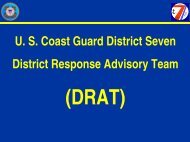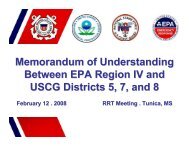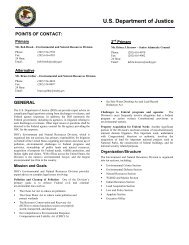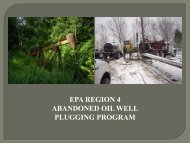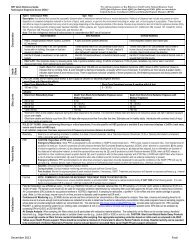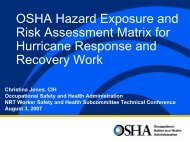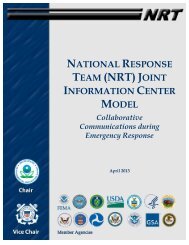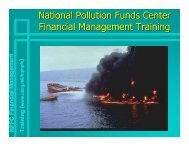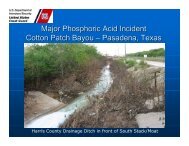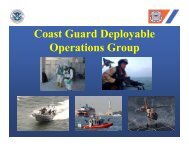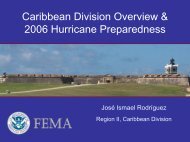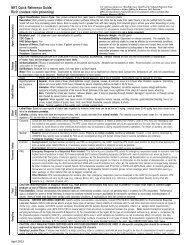USE OF DISPERSANTS - U.S. National Response Team (NRT)
USE OF DISPERSANTS - U.S. National Response Team (NRT)
USE OF DISPERSANTS - U.S. National Response Team (NRT)
- No tags were found...
You also want an ePaper? Increase the reach of your titles
YUMPU automatically turns print PDFs into web optimized ePapers that Google loves.
CommanderSeventh Coast Guard DistrictBrickell PlazaFederal Building909 SE First AvenueMiami, Florida 33131-3050Staff Symbol: (m)Phone: (305) 536-5651Mr. James OlandU.S. Fish and Wildlife ServiceP.O. Box 491Boqueron, PR 006221646503 Mar 97Dear Mr. Oland:In accordance with the requirements of the Endangered Species Act and 50 CFR 402.12, I am enclosing for youreview and concurrence our “Biological Assessment of Effects on Listed Species of Caribbean Regional <strong>Response</strong><strong>Team</strong> Letters of Agreement on Limited Use of Oil Spill Dispersants.”These Letters of Agreement (LOA) (enclosures 2 and 3) pre-authorize the limited use of dispersants by the predesignatedU.S. Coast Guard Federal On-Scene Coordinator on oil discharges impacting the waters of theCommonwealth of Puerto Rico and the Territory of the U.S. Virgin Islands. These LOAs implement Subpart J of the<strong>National</strong> Oil and Hazardous Substances Contingency Plan (NCP) and are signed by the U. S. Coast Guard, U.S.Environmental Protection Agency, the U.S. Department of the Interior, the U.S. Department of Commerce, and theCommonwealth of Puerto Rico, and Territory of the U.S. Virgin Islands. It is understood that this may constitute afederal action in areas where endangered and threatened species are known to occur and consultation under Section7 of the Endangered Species Act may be required.Our biological assessment indicates that the listed species are not likely to be adversely affected by this action. Theuse of dispsersants offers strong potential for net environmental benefit during an oil spill by allowing for increasedprotection of nearshore, shoreline, and down-current biological resources and habitat and provides for a more rapidremoval of oil from the environment thus subjecting fewer resources to potential impact. To assist your review, I amalso enclosing information on the <strong>National</strong> Contingency Plan (NCP) Product Schedule and Technical ProductBulletins for Dispersants.The U.S. Fish and Wildlife Service (USFWS) review of our Biological Assessment for the “Region IV Regional<strong>Response</strong> <strong>Team</strong> Policy for the Use of Dispersants in Ocean and Coastal Waters” (enclosure 6) concurred with ourdetermination that the proposed dispersant pre-authorization was not likely to adversely affect the listed speciesunder the responsibility of the Service (enclosure 7). All listed species considered in this Biological Assessment forthe Caribbean were also considered in the Biological Assessment for Region IV. Although patterns of speciesbehavior and habitat use may vary among populations distributed in different geographic areas, these differences arenot expected to be significant enough to result in a higher likelihood of impact from dispersant pre-authorization inthe Caribbean than in Region IV.Lieutenant Commander Bradford Benggio, <strong>National</strong> Oceanic and Atmospheric Administration (NOAA) ScientificSupport Coordinator to the Seventh Coast Guard District has discussed this matter with Mr. Jorge Saliva of yourstaff, with Mr. James Lee, U.S. Department of the Interior trustee representative to the Caribbean Regional <strong>Response</strong><strong>Team</strong>, and Mr. Gregory Hogue, Dispersant Sub-Committtee Chair to the Caribbean Regional <strong>Response</strong> <strong>Team</strong>.



